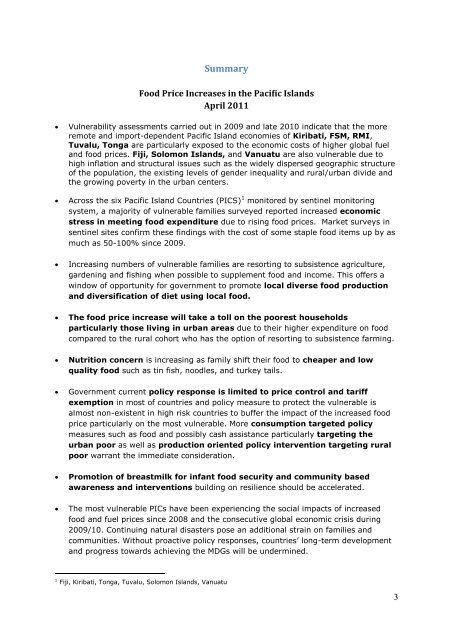Food Price Increases in the Pacific Islands - Unicef
Food Price Increases in the Pacific Islands - Unicef
Food Price Increases in the Pacific Islands - Unicef
Create successful ePaper yourself
Turn your PDF publications into a flip-book with our unique Google optimized e-Paper software.
Summary<br />
<strong>Food</strong> <strong>Price</strong> <strong>Increases</strong> <strong>in</strong> <strong>the</strong> <strong>Pacific</strong> <strong>Islands</strong><br />
April 2011<br />
<br />
<br />
<br />
<br />
<br />
<br />
<br />
<br />
Vulnerability assessments carried out <strong>in</strong> 2009 and late 2010 <strong>in</strong>dicate that <strong>the</strong> more<br />
remote and import-dependent <strong>Pacific</strong> Island economies of Kiribati, FSM, RMI,<br />
Tuvalu, Tonga are particularly exposed to <strong>the</strong> economic costs of higher global fuel<br />
and food prices. Fiji, Solomon <strong>Islands</strong>, and Vanuatu are also vulnerable due to<br />
high <strong>in</strong>flation and structural issues such as <strong>the</strong> widely dispersed geographic structure<br />
of <strong>the</strong> population, <strong>the</strong> exist<strong>in</strong>g levels of gender <strong>in</strong>equality and rural/urban divide and<br />
<strong>the</strong> grow<strong>in</strong>g poverty <strong>in</strong> <strong>the</strong> urban centers.<br />
Across <strong>the</strong> six <strong>Pacific</strong> Island Countries (PICS) 1 monitored by sent<strong>in</strong>el monitor<strong>in</strong>g<br />
system, a majority of vulnerable families surveyed reported <strong>in</strong>creased economic<br />
stress <strong>in</strong> meet<strong>in</strong>g food expenditure due to ris<strong>in</strong>g food prices. Market surveys <strong>in</strong><br />
sent<strong>in</strong>el sites confirm <strong>the</strong>se f<strong>in</strong>d<strong>in</strong>gs with <strong>the</strong> cost of some staple food items up by as<br />
much as 50-100% s<strong>in</strong>ce 2009.<br />
Increas<strong>in</strong>g numbers of vulnerable families are resort<strong>in</strong>g to subsistence agriculture,<br />
garden<strong>in</strong>g and fish<strong>in</strong>g when possible to supplement food and <strong>in</strong>come. This offers a<br />
w<strong>in</strong>dow of opportunity for government to promote local diverse food production<br />
and diversification of diet us<strong>in</strong>g local food.<br />
The food price <strong>in</strong>crease will take a toll on <strong>the</strong> poorest households<br />
particularly those liv<strong>in</strong>g <strong>in</strong> urban areas due to <strong>the</strong>ir higher expenditure on food<br />
compared to <strong>the</strong> rural cohort who has <strong>the</strong> option of resort<strong>in</strong>g to subsistence farm<strong>in</strong>g.<br />
Nutrition concern is <strong>in</strong>creas<strong>in</strong>g as family shift <strong>the</strong>ir food to cheaper and low<br />
quality food such as t<strong>in</strong> fish, noodles, and turkey tails.<br />
Government current policy response is limited to price control and tariff<br />
exemption <strong>in</strong> most of countries and policy measure to protect <strong>the</strong> vulnerable is<br />
almost non-existent <strong>in</strong> high risk countries to buffer <strong>the</strong> impact of <strong>the</strong> <strong>in</strong>creased food<br />
price particularly on <strong>the</strong> most vulnerable. More consumption targeted policy<br />
measures such as food and possibly cash assistance particularly target<strong>in</strong>g <strong>the</strong><br />
urban poor as well as production oriented policy <strong>in</strong>tervention target<strong>in</strong>g rural<br />
poor warrant <strong>the</strong> immediate consideration.<br />
Promotion of breastmilk for <strong>in</strong>fant food security and community based<br />
awareness and <strong>in</strong>terventions build<strong>in</strong>g on resilience should be accelerated.<br />
The most vulnerable PICs have been experienc<strong>in</strong>g <strong>the</strong> social impacts of <strong>in</strong>creased<br />
food and fuel prices s<strong>in</strong>ce 2008 and <strong>the</strong> consecutive global economic crisis dur<strong>in</strong>g<br />
2009/10. Cont<strong>in</strong>u<strong>in</strong>g natural disasters pose an additional stra<strong>in</strong> on families and<br />
communities. Without proactive policy responses, countries‟ long-term development<br />
and progress towards achiev<strong>in</strong>g <strong>the</strong> MDGs will be underm<strong>in</strong>ed.<br />
1 Fiji, Kiribati, Tonga, Tuvalu, Solomon <strong>Islands</strong>, Vanuatu<br />
3

















